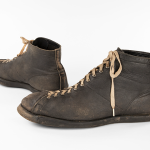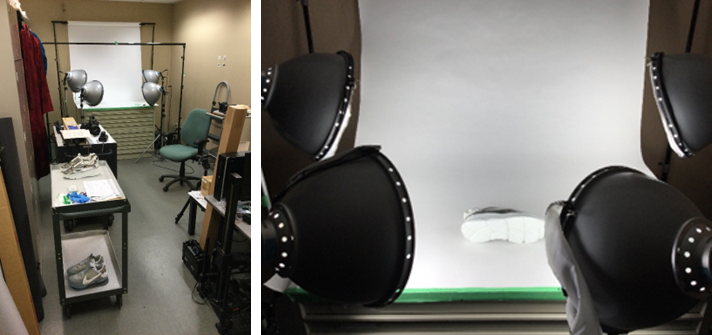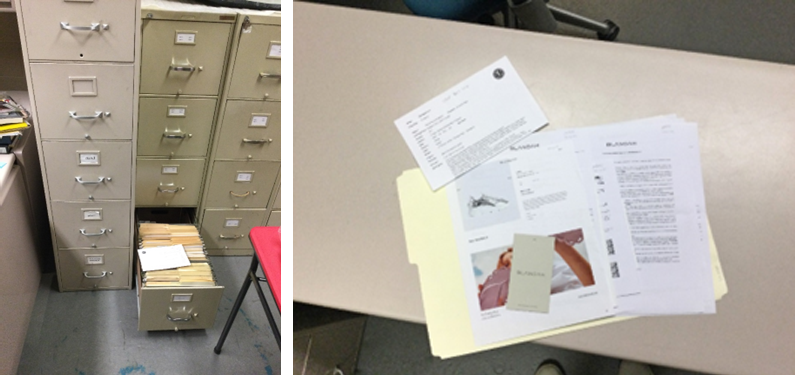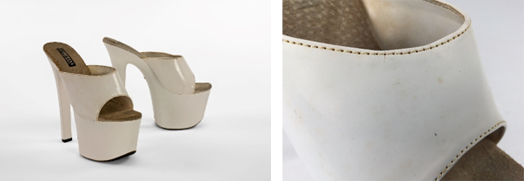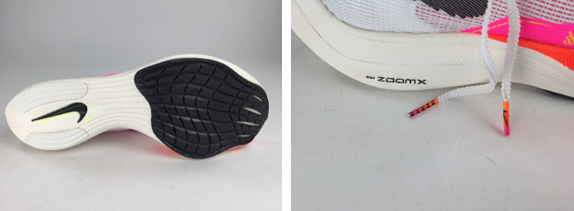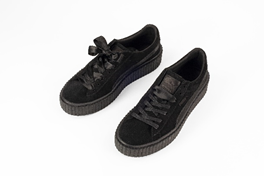It’s important to have written and visual documentation on the condition of an artefact. This allows one to keep track of any changes to the materials, particularly for footwear composed of modern materials. Condition reports are written for incoming loans when other institutions and private collectors lend to upcoming exhibitions at the BSM. We also compose reports for outgoing loans to other museums that are borrowing to enhance the content of their future exhibitions. This allows the conservators at the destination to determine if any damage has occurred during shipment when comparing accompanying documentation.
The selected artefact is first photographed from a variety of angles (right foot first: sole, proper right side, vamp, proper left side, heel area and interior). Close-ups are taken of independent elements and to track potential changes in existing damage. Next, their documentation file is examined to see if there is any relevant information, such as a list of materials sourced from the manufacturer or previous conservation treatments.
The images are processed through Photoshop and printed off. The written report follows the same geography as the photography session. Additional information can include: if there are stains on internal supports or strong or unusual odours (and I’m not referring to stinky feet! which is a common question but a very rare occurrence). For instance, rubber can have a strong sulphur smell which is referred to as outgassing or off gassing and can cause internal supports to turn yellow over time.
Any physical abnormalities or unexpected historical additions are noted on the printed photographs. The condition report is attached to the annotated images and the documentation is added to the artefact file.
Currently we are examining plastics that have the potential to deteriorate. The shoes, pictured below, are covered with a polyurethane film that gives them the shiny white patent look. The vamp, which in parts is still shiny, has become quite dull and there are fine cracks in the film emanating from the holes created by the top stitching. These shoes were purchased by actor Catherine O’Hara as part of an outfit she created when reprising her character Lola Heatherton for a charity event. They were donated to the BSM in 2018.
Writing these condition reports is part of a much larger project. As mentioned in previous blogs, we are trying to determine which shoes will be moved to the new, retro fitted storage room. These baseline reports will establish current condition so that we have a reference with which to monitor any changes to component materials over time.
As we prepared for the new exhibition, Future Now, condition reports are updated or if they don’t already exist, baseline documents are created. This pair of sneakers was purchased specifically for the aforementioned exhibition. When they are new, fresh from the manufacturer, it’s the best time to write a report and photograph all the component materials in their original state. Details are taken of all the elements including the aglets at the ends of the laces.
Writing these reports is an ongoing project. It gives the conservator an opportunity to examine each shoe up close and in detail. Listing all the materials used in each structural component allows the observer to witness how they age over time as well as interact with each other.
Ada Hopkins
Conservator


